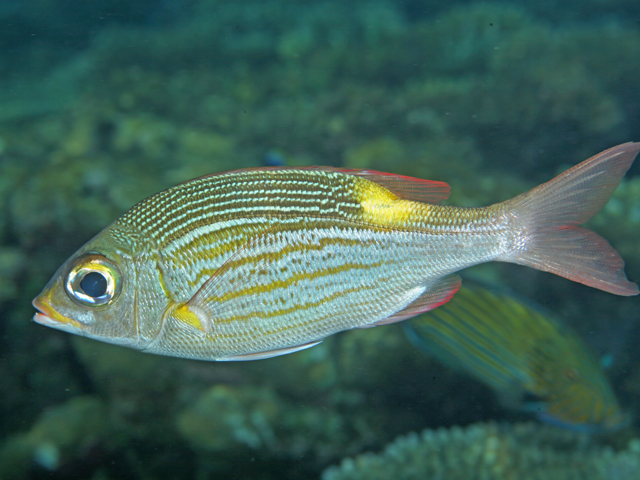| Lethrinidae (Emperors or scavengers), subfamily: Monotaxinae |
| 42.3 cm FL (male/unsexed); max.weight: 2,098.0 g |
|
reef-associated; marine; depth range 0 - 30 m, non-migratory |
| Indo-Pacific: East Africa to the Tuamoto Islands (excluding the Hawaiian Islands), north to Japan, south to Australia. Recently reported from Norfolk Island (Ref. 8880). |
|
Dorsal spines (total): 10-10; Dorsal soft rays (total): 10-10; Anal spines: 3-3; Anal soft rays: 8-10. Description: Dorsal head profile moderately sloped; eye relatively large, its diameter about equal to length of snout. The cheeks are scaled; maxilla with a longitudinal reticulated ridge. The inner pectoral fin base are without scales. Back region is brown with narrow silvery stripes. The rest of the head and body mainly silver to gray except for 4 or 5 brownish-orange on lower 2/3 of side. There is a prominent golden yellow blotch directly below the posterior part of the dorsal fin just in front of the caudal peduncle (Ref. 2295). Body depth 2.3-2.8 in SL (Ref. 90102). |
| Inhabits subtidal reef flats, lagoons, and seaward reefs (Ref. 9710). May be solitary or in groups (Ref. 90102). Sometimes forms aggregations of about a hundred or more individuals. Feeds at night on benthic invertebrates like crabs and gastropods, occasionally on small fish. Usually marketed fresh. Minimum depth reported taken from Ref. 128797. |
|
Least Concern (LC); Date assessed: 09 March 2015 Ref. (130435)
|
| reports of ciguatera poisoning |
Source and more info: www.fishbase.org. For personal, classroom, and other internal use only. Not for publication.
